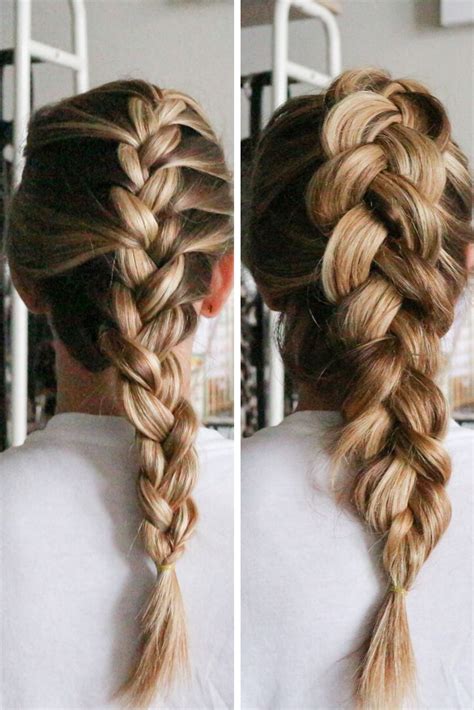Introduction
Braiding, the art of entwining strands of hair into intricate patterns, has been a staple of hair styling for centuries. Among the most popular braiding techniques are the French braid and the Dutch braid. While both create beautiful and versatile hairstyles, subtle differences set them apart. This article delves into the captivating world of French and Dutch braids, comparing their techniques, benefits, and applications.

French Braid: A Timeless Masterpiece
The French braid, also known as the “classical braid,” has been a fixture in hair styling for generations. Its distinct design, where hair is woven together in an underhand motion, creates a slightly raised pattern on the scalp.
Key Features of a French Braid:
- Underhand Technique: The French braid is created by repeatedly crossing sections of hair under the central strand.
- Tight and Controlled: French braids are typically tight, with individual hair strands intertwined securely.
- Raised Pattern: The underhand technique results in a raised braid that sits above the scalp.
- Versatility: French braids can be styled in various ways, including buns, ponytails, and crowns.
Benefits of French Braids:
- Secure Hold: French braids provide excellent hair control, preventing tangles and flyaways.
- Volume and Texture: The raised pattern adds volume and texture to the hair, creating a voluminous look.
- Heat-Free Styling: French braids are a heat-free styling option, protecting the hair from potential damage.
- Versatility: French braids can complement a wide range of outfits and occasions, making them a timeless hair styling choice.
Pros:
- Secure and long-lasting hold
- Creates volume and texture
- Heat-free styling option
- Versatile and adaptable to various outfits and occasions
Cons:
- Can be time-consuming and intricate
- May cause tension on the scalp if braided too tightly
- Not ideal for short hair
Dutch Braid: A Striking Alternative
The Dutch braid, often called the “inverted French braid,” takes a unique approach to braiding. Unlike the French braid, it employs an overhand technique, resulting in a raised braid that sits atop the head.
Key Features of a Dutch Braid:
- Overhand Technique: The Dutch braid is created by repeatedly crossing sections of hair over the central strand.
- Loose and Textured: Dutch braids are generally looser and more textured than French braids.
- Raised Braid: The overhand technique creates a braid that is raised and voluminous, resting on top of the scalp.
- Statement Piece: Dutch braids make a bold statement, adding instant drama to any hairstyle.
Benefits of Dutch Braids:
- Eye-Catching Volume: The raised braid creates a dramatic and eye-catching effect, perfect for special occasions or casual wear.
- Versatile and Modern: Dutch braids add a modern and edgy touch to any hairstyle, complementing various outfits and aesthetics.
- Unique and Intricate: The overhand technique creates a unique and intricate braid that stands out from traditional French braids.
- Headband Alternative: Dutch braids can serve as a stylish and functional headband, keeping hair out of the face while adding a touch of flair.
Pros:
- Dramatic volume and eye-catching effect
- Versatile and complements various styles
- Unique and intricate design
- Can act as a stylish headband alternative
Cons:
- Can be more difficult to master than French braids
- May not be as secure as French braids
- Requires more hair volume to create the desired effect
Comparison Table: French vs. Dutch Braids
| Feature | French Braid | Dutch Braid |
|---|---|---|
| Technique | Underhand | Overhand |
| Braid Placement | Raised above the scalp | Raised on top of the scalp |
| Appearance | Tight and controlled | Loose and textured |
| Volume and Texture | Adds volume and texture | Creates dramatic volume and texture |
| Hold | Secure and long-lasting | Moderate hold |
| Versatility | Timeless and versatile | Modern and eye-catching |
Applications and Styling Inspiration
French Braids:
- Formal Events: French braids are a classic choice for weddings, proms, and other formal occasions.
- Casual Wear: French braids add a touch of elegance to everyday outfits, keeping hair neat and tidy.
- Half-Up Styles: French braids can be incorporated into half-up hairstyles, creating a romantic and ethereal look.
- Intricate Updos: French braids form the foundation of elaborate updos, adding texture and detail to complex hairstyles.
Dutch Braids:
- Bohemian Goddess Look: Dutch braids are perfect for creating a free-spirited and bohemian goddess look.
- Braided Crowns: Dutch braids can be interwoven to form stunning braided crowns, adding a touch of whimsy and drama.
- Headband Braids: Dutch braids can be styled as headbands, keeping hair out of the face while making a bold statement.
- Statement Pigtails: Dutch braids can transform simple pigtails into eye-catching and stylish statement pieces.
Final Thoughts
French and Dutch braids are both versatile and stunning braiding techniques that cater to different preferences and hair types. Whether you seek a timeless classic or a modern and eye-catching look, these braiding methods offer endless possibilities for hair expression. Embrace your creativity, experiment with different variations, and let your braids speak volumes about your style and personality.
